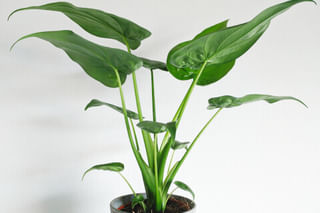The ultimate guide to taking care of Alocasia Cucullata

If you're on the hunt for a plant that brings a touch of tropical flair to your home, look no further than the Alocasia Cucullata, often affectionately known as the Chinese Water Plantain. With its deep green, heart-shaped leaves, this beauty not only serves as a vibrant statement piece but also adds a cozy vibe to any space. Whether you’re a seasoned plant parent or just starting your indoor gardening journey, this guide is here to make caring for your Alocasia as easy as it can be. Get ready to impress your friends with your green thumb!
To give you the best chance to take care of this plant, I've broken down the caring process into a few different steps. These steps give you the most in-depth information to teach you everything you need to know about caring for your plant.
-
How to care for an Alocasia Zebrina
1
. How to care for an Alocasia Zebrina
Back to the top
The Alocasia Zebrina is a beautiful plant, but it's not very easy to take care of. In this guide, we'll go over the basics: Light requirements, watering needs, fertilizer, soil, and more. All these tips are written to make it easier for you to take care of your Alocasia Zebrina, even if you're a beginner.
Read "How to care for an Alocasia Zebrina"
Taking care of your Alocasia Cucullata is easier than you might think! This plant thrives in bright, indirect light, so positioning it near a window is key to keeping those leaves vibrant and happy. Be mindful of watering, these beauties prefer their soil to dry out a bit between waterings, so skip the soggy roots by checking the top couple of inches first. Humidity levels can also play a huge role in its health; consider misting your plant regularly or placing it in a humidity tray to keep it feeling refreshed, particularly during those dry winter months.
Want to dive deeper into the art of Alocasia care? We've got you covered! Check out my in-depth guides on watering techniques, optimal lighting, and how to spot those pesky pests before they become a problem. Your journey to becoming an Alocasia aficionado starts here! Click the links for all the tips and tricks you need to create a thriving indoor oasis!
Scientific classification of Alocasia cucullata
Plants go by many names, but it can become confusing very quickly if you're talking about different plants with the same nickname. That's why I'm including the scientific name of the plant, so we're all on the same page!
|
Classification
|
Name
|
|
Family
|
Araceae |
|
Genus
|
Alocasia |
|
Species
|
Alocasia cucullata |
Common nicknames for Alocasia cucullata
If you don't recognize the scientific name of Alocasia cucullata, you might recognize one of these more common names instead!
- Buddha's hand
- Chinese ape
- Chinese taro
- Chinese water plantain
- Caladium colocasia
- Colocasia rugosa
- Caladium rugosum
- Alocasia rugosa
- Panzhuyuia omeiensis
- Arum cucullatum
- Colocasia cucullata
- Caladium cucullatum
- Colocasia cochleata
Frequently asked questions
How should you water the Buddha's hand?
The Buddha's hand likes to be watered occasionally, but also needs to soil to dry out slightly. Water when the top of the soil has dried out.
How much sunlight does the Buddha's hand need?
The Buddha's hand does best in a spot where it gets bright, indirect sunlight. This spot is always bright but never gets direct sunlight.
How much fertilizer does the Buddha's hand need?
The Buddha's hand needs quite a bit of energy to grow, so you should fertilize it once per month in the spring and summer.
What is the best soil for the Buddha's hand?
The Buddha's hand likes to be watered when the top of the soil is dry, so use a soil mix that drains excess moisture quickly and holds onto some moisture for a few days.
What is the ideal temperature for the Buddha's hand?
The Buddha's hand prefers a spot that consistently stays between 18 - 25°C (64 - 77°F).
How do you propagate the Buddha's hand?
To propagate the Buddha's hand, you'll have to divide the Buddha's hand and grow each part separately. This is quite damaging, so don't do this too often.
How often should you repot the Buddha's hand?
You should repot your Buddha's hand once every 2 year(s). This helps your Buddha's hand to stay healthy for many years.
Is the Buddha's hand easy to take care of?
The Buddha's hand is not the best plant for beginners, but also not very difficult to take care of.
Didn't find what you were looking for?
We have resources about other plants and plant-related topics as well.
Perhaps these resources contain the information you're looking for.
I've written a lot of guides about all kinds of aspects of taking care of plants, but I could've missed that specific topic you were looking for. If that's the case, you can request a plant guide. This way I can provide you with the information you need quickly and you won't have to wonder if you're taking care of your plant properly anymore.


